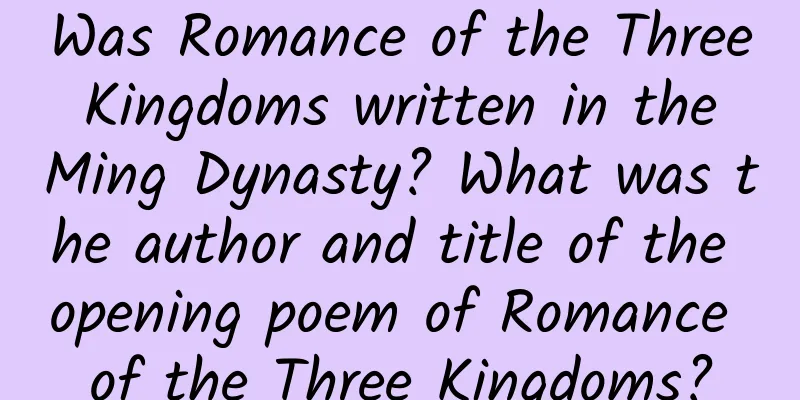Was Romance of the Three Kingdoms written in the Ming Dynasty? What was the author and title of the opening poem of Romance of the Three Kingdoms?

|
The Romance of the Three Kingdoms uses characters as carriers to vividly interpret the basic spirit of Chinese traditional culture, namely, benevolence, righteousness, courtesy, wisdom, trustworthiness, courage and other core elements of the value system of Chinese traditional culture. So, was the Romance of the Three Kingdoms written in the Ming Dynasty? What is the author and title of the opening lyrics of the Romance of the Three Kingdoms? Let's take a look at the introduction of Encyclopedia Knowledge Network to answer these questions! Contents of this article 1. Was Romance of the Three Kingdoms written in the Ming Dynasty? 2. What is the author and title of the opening poem of Romance of the Three Kingdoms? 3. A brief introduction to the Romance of the Three Kingdoms 1Was Romance of the Three Kingdoms written in the Ming Dynasty?The Romance of the Three Kingdoms was written in the Ming Dynasty. It is a long historical novel in chapter form created by the novelist Luo Guanzhong in the late Yuan Dynasty and early Ming Dynasty based on Chen Shou's "Three Kingdoms", Pei Songzhi's annotations and folk stories and legends of the Three Kingdoms through artistic processing. After the work was completed, several versions such as the Jiajing Renwu version were circulated in the world. In the late Ming and early Qing dynasties, Mao Zonggang reorganized the chapter titles, corrected the wording, and changed the poems and essays of "Romance of the Three Kingdoms". This version also became the highest level and most widely circulated version among many versions. 2What is the author and title of the opening poem of Romance of the Three Kingdoms?The author is Yang Shen, a writer of the Ming Dynasty, and the title is "Linjiangxian: The Rolling Yangtze River Flows Eastward". The original text is as follows: The Yangtze River rolls eastward, and the waves wash away all heroes. Success and failure are all in vain. The green mountains remain, and the sunsets are red again. The white-haired fisherman and woodcutter on the river bank are used to watching the autumn moon and spring breeze. A pot of muddy wine is a happy reunion. So many things in the past and present, all turned into jokes. "Linjiangxian: The Yangtze River Flows East" is the opening lyric of the third section "Talking about Qin and Han" of "Twenty-one Historical Tanci" written by Yang Shen, a Ming Dynasty writer. Later, Mao Zonggang and his son put it at the beginning of "Romance of the Three Kingdoms" when they commented on it. The "Yangtze River", "flowing water", "sprays", "heroes", "green mountains", "sunset", "fishermen and woodcutters", "river bank", "autumn moon", "spring breeze", and "muddy wine" in the lyric are lofty and indifferent. The vivid words such as "rolling", "washed away", "turning around empty", "still there", "several times", "used to seeing", "happy to meet", and "joking talk" set off these images, adding a bit of dynamism to the quiet atmosphere of this lyric. Yang Shen was a writer in the Ming Dynasty and the first of the three great talents of the Ming Dynasty. His courtesy name was Yongxiu and his pseudonym was Sheng'an. Later, he was exiled to southern Yunnan, so he called himself Bonan Shanren and Jinma Biji Laobing. 3A brief account of the Romance of the Three KingdomsThe Romance of the Three Kingdoms is one of the four great classical Chinese novels. It is the first long historical novel in the form of chapters. Its full name is The Romance of the Three Kingdoms (also known as The Romance of the Three Kingdoms). The author is Luo Guanzhong, a famous novelist in the late Yuan Dynasty and early Ming Dynasty. After the Romance of the Three Kingdoms was completed, there were many versions such as the Jiajing Renwu version. In the late Ming and early Qing dynasties, Mao Zonggang reorganized the chapter titles, revised the text, and changed the poems and prose of The Romance of the Three Kingdoms. [1] The Romance of the Three Kingdoms describes the history of nearly a hundred years from the end of the Eastern Han Dynasty to the beginning of the Western Jin Dynasty. It mainly describes wars, telling the story of the warring factions at the end of the Eastern Han Dynasty and the political and military struggles between the three kingdoms of Wei, Shu and Wu, and finally the story of Sima Yan unifying the three kingdoms and establishing the Jin Dynasty. It reflects the transformation of various social struggles and contradictions in the Three Kingdoms era, summarizes the great historical changes of this era, and creates a group of powerful heroes of the Three Kingdoms. The book can be roughly divided into five parts: the Yellow Turban Rebellion, Dong Zhuo's Rebellion, the Warring States Period, the Three Kingdoms, and the Three Kingdoms' Return to the Jin Dynasty. On the vast historical stage, magnificent war scenes were staged. The author Luo Guanzhong integrated the Thirty-Six Strategies of War into the text, which not only contains plots but also military strategies. |
Recommend
How to cultivate primary school students' interest in reading? What are the methods to cultivate children's love of reading?
Reading improves the realm of life, strengthens t...
Postpartum urination pain
During the childbirth process, not only does a la...
What kind of exercise can help you recover quickly after giving birth?
Due to excessive intake of nutrients during pregn...
Is it normal to have excessive vaginal discharge at 34 weeks of pregnancy?
Discharge is actually a kind of female secretion....
Keyboard Man's "Mouse Hand" - Carpal Tunnel Syndrome
In today's society, information is exploding....
How to deal with endometriosis during cesarean section?
Nowadays, more and more women choose cesarean sec...
What should girls do if they have blackheads on their noses?
Having blackheads on the nose is the most trouble...
How many days after menstrual period is the safe period?
Nowadays, many women choose to calculate their sa...
Easy recipes to eat after menstruation, what to eat after menstruation
During menstruation, women have to pay attention ...
How to treat ovarian inflammation
Oophoritis is a common gynecological inflammation...
Is thin and soft hair a sign of kidney deficiency? How can boys improve their thin and soft hair?
Due to the rapid increase in the pace of life, ma...
Is it normal to have little bleeding after medication abortion?
Medical abortion refers to the phenomenon that wo...
Why does kelp form knots? Why does kelp form knots (and what are their uses)?
Kelp is a common food rich in iodine. It has a va...
Will ovulation occur on the first day after menstruation ends?
If the menstrual cycle is 23 days, the menstrual ...









